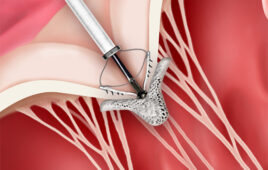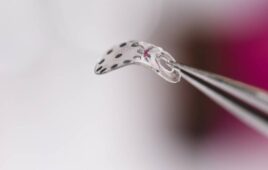MINNEAPOLIS–(BUSINESS
WIRE)–Medtronic, Inc. today announced the first patient was enrolled in
the FIRE AND ICE clinical trial, which is a prospective, randomized,
multinational head-to-head clinical trial comparing the long-term safety,
effectiveness and ease of use of the Medtronic Arctic Front® Cardiac
CryoAblation System compared to the Biosense Webster CARTO® System Guided
THERMOCOOL® Catheter to treat patients with symptomatic paroxysmal atrial
fibrillation. Results from the trial, expected in 2014, could potentially
impact atrial fibrillation treatment guidelines by providing further clinical
evidence regarding the benefits of the Arctic Front system in treating a
largely underserved patient population.
“Through this rigorously designed study, we hope to further
validate the long-term treatment benefits associated with cryoballoon ablation,”
said Karl-Heinz Kuck, M.D., principal investigator and director of cardiology,
at Asklepios Klinik St.
Georg, Hamburg,
Germany.
“Given the Arctic Front systems clinically robust safety and efficacy profile,
combined with its straightforward simplicity, this innovative medical
technology has the potential to become the standard of care in treating
paroxysmal atrial fibrillation.”
The largest clinical study to date to compare two atrial
fibrillation ablation devices, the FIRE AND ICE trial will enroll up to 572
patients from up to 20 medical centers throughout Europe.
Patients participating in the study must be diagnosed with symptomatic
paroxysmal atrial fibrillation and must have failed at least one antiarrhythmic
drug. Participants will be followed for an average of one year after initial
ablation. The primary endpoint of the trial is the absence of atrial
arrhythmias without antiarrhythmic drug therapy and without persistent
procedure-related serious adverse events such as strokes, pulmonary vein
stenosis and phrenic nerve injury at six and 12 months following ablation. Key
secondary endpoints that will be assessed include procedural data (total
procedure duration, time of fluoroscopy and duration of hospital stay), quality
of life, sedation and the need for atrial flutter ablation.
The numerous short- and long-term benefits of the Arctic
Front system have been well established via numerous studies, as well as in the
clinical setting, with more than 20,000 successful procedures conducted to
date. According to data from the pivotal STOP AF (Sustained Treatment of
Paroxysmal Atrial Fibrillation) trial, on which the FDA approval of the Arctic
Front Cardiac CryoAblation System was based, 69.9 percent of patients treated
with the innovative technology were free from atrial fibrillation at one year,
compared to 7.3 percent of patients treated with drug therapy only. Patients
enrolled in the study displayed a significant reduction of symptoms, a decrease
in the use of anti-arrhythmic drug therapy and substantial improvements in both
physical and mental quality of life factors. The study also demonstrated that
treatment with the device is safe, with limited serious procedure-related
adverse events (3.1 percent).
“Medtronic is committed to building upon a strong foundation
of scientific evidence to help inform physicians clinical decisions and help
them select technologies that are best suited for their individual patients,”
said Reggie Groves, vice president and general manager of Medtronics AF
Solutions business. “We look forward to further confirming – via this
large-scale, multicenter trial – that our novel cryoballoon ablation technology
offers a compelling alternative to radiofrequency ablation.”
To treat atrial fibrillation, the goal of minimally-invasive
catheter ablation therapy is to isolate the pulmonary veins by blocking the
conduction of electrical signals that trigger erratic heart rhythms in the
upper heart chambers. The Arctic Front cryoballoon system freezes and blocks
these erratic triggers, while conventional ablation therapy uses radiofrequency
energy with a point-by-point catheter to isolate the triggers by heating. The
freezing helps the balloon maintain contact with the heart tissue during the
procedure, allowing for greater catheter stability. A leading advancement from
currently available ablation tools, cryoablation has been shown to be faster
for physicians to use than a point-by-point catheter, and it has been proven
more effective than anti-arrhythmic drug therapy in treating patients with
paroxysmal atrial fibrillation.
About the Arctic Front Cardiac CryoAblation Catheter System
The Arctic Front Cardiac CryoAblation Catheter System is designed to be used
with fluoroscopy and does not require the use of complex, three-dimensional
mapping systems. The technologies offered in the system include:
- The Arctic Front Cryoballoon, which inflates and fills with
coolant to ablate the tissue where the pulmonary veins enter the left atrium; - The FlexCath® Steerable Sheath, which helps deliver and
position the cryocatheter in the left atrium; - The Achieve™ Mapping Catheter, an intra-cardiac
electrophysiology recording catheter used to assess pulmonary vein isolation
when treating paroxysmal atrial fibrillation. - The Freezor® MAX Cardiac CryoAblation Catheter, which is a
single-point catheter used to provide additional ablations, as needed; and, - The CryoConsole, which houses the coolant, electrical and
mechanical components that run the catheters during a cryoablation procedure.
About Atrial Fibrillation
Atrial fibrillation is the most common and one of the most undertreated heart
rhythm disorders, affecting more than 7 million people worldwide. It is
estimated that half of all diagnosed atrial fibrillation patients fail drug
therapy, and if left untreated patients have up to a five times higher risk of
stroke and an increased chance of developing heart failure. Additionally, since
atrial fibrillation is often age-related, as the global population continues to
grow older, the need for more effective treatment options is escalating.
Paroxysmal atrial fibrillation is a type of atrial
fibrillation in which irregular heartbeats in the upper chambers start and stop
suddenly on their own, usually for minutes or days at a time.
In collaboration with leading clinicians, researchers and
scientists worldwide, Medtronic offers the broadest range of innovative medical
technology for the interventional and surgical treatment of cardiovascular
disease and cardiac arrhythmias.
About Medtronic
Medtronic, Inc. (www.medtronic.com), headquartered in Minneapolis, is the global leader in medical
technology – alleviating pain, restoring health, and extending life for
millions of people around the world.
Posted by Sean Fenske, Editor-in-Chief, MDT




